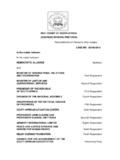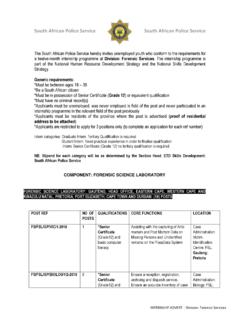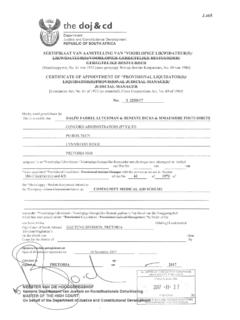Transcription of DIVISION OF REVENUE - National Treasury
1 57 DIVISION OF REVENUEThe intergovernmental budget processIntroductionThe 1998 Budget tabled by the Minister of Finance included three-year allocations for the National government, the nine provinces andlocal government. These allocations reflected the outcome of alengthy consultative process among stakeholders and the applicationof an objective, demographically based formula in determining theprovincial equitable revised allocations set out here are lower than those originallyannounced in March 1998. The decreases are largely due to changesin the economic outlook, explained in chapter 2.
2 The allocations toeach of the nine provinces also reflect the impact of using the final,rather than the preliminary, results of the 1996 census in theprovincial equitable shares The intergovernmental budget process is guided by the Intergovern-Fiscal Relations Actmental Fiscal Relations Act, which took effect on 1 January Act establishes a formal process for consideringintergovernmental budget issues and is designed to facilitateconsultation and promote a budget-making process that is fair andequitable. It provides a legislative basis for co-operative governancethrough the Budget Council, which brings together the FinanceMinister and provincial Finance MECs, and the Budget Forum,which, in addition includes organised local 1998, the Budget Council met regularly to discuss budgetgovernanceissues and co-ordinate the budget preparation process.
3 In addition,the Budget Council met with its counterpart intergovernmentalbodies in Education, Health and Welfare. These joint meetings ofnational Ministers and provincial MECs gave important direction tothe formulation and content of the budgets of the three socialservices that make up about 85 per cent of provincial of revenueThe Minister of Finance is required to table a DIVISION of RevenueBill alongside the National Budget. It must be accompanied by amemorandum linking the allocations to relevant Constitutional51998 Medium Term Budget Policy Statement58requirements and the recommendations of the Financial and introduction of the MTEF process has improvedintergovernmental coordination and led to several new initiatives inthe budget process.
4 National departments, provinces and localgovernments came together to play a much more crucial role in thedevelopment of sectoral policy, particularly in the areas ofeducation, health, welfare and personnel financialThese developments will further improve the link between policyplanningplanning and financial planning, which has been lacking ingovernment programmes in the past. The co-operative governanceframework that is evolving signals a more mature approach togovernance, integrating both National priorities and provincial andlocal focus of intergovernmental relations now extends beyondfinancial co-ordination, towards a greater role for various spheres ofgovernment in the policy arena.
5 This will help bring funding andpolicy considerations in line with the new intergovernmentalframework and the availableEquitable sharesThe Constitution provides that each sphere of government - National ,provincial and local - is entitled to an equitable share of revenueraised nationally to enable it to provide basic services and performthe functions allocated to it. The equitable DIVISION of REVENUE takesinto account the functions assigned to each sphere and the capacityof each government to pay for these functions through own receiptsand equitable share is an unconditional allocation.
6 Provincial andlocal governments, being distinct spheres of government, determinethe priorities for these funds and are directly accountable for howthey are spent. However, provincial and local government spendingis largely assigned to functions in which National legislation setsnorms and grantsIn addition to their equitable share, provinces and local governmentsmay also receive other allocations from the National share to whichthe National government may attach conditions. In the 1998 Budget,provinces and local governments received approximatelyR9,0 billion in conditional allocations from the National share ofrevenue.
7 A further R4,2 billion was assigned to provincial agenciesresponsible for implementing specific policies and programmes onbehalf of National 5: DIVISION of Revenue59 Resources to shareIn addition to collecting REVENUE , government currently borrows tomeet its expenditure requirements. It is the balance of nationalrevenue plus borrowing, less debt obligations, which represents thetotal pool of resources available for sharing. Government has also setaside a contingency reserve for each of the MTEF years. Thepurpose of this reserve is to cushion public expenditure fromunforeseen events, such as a deterioration of economic performanceor a natural disaster.
8 Own revenuesProvincial and local government own-revenues are not included inthe calculation of equitable shares. The Constitution placeslimitations on the types of own REVENUE that provincial and localgovernment have access to, and indicates that any additional revenueraised by a province or municipality cannot be deducted from itsequitable powersThe Constitution provides for National legislation to govern thepower of provinces and local government to borrow. Subject tonational oversight, loans may be raised for capital expenditure and tobridge temporary REVENUE shortfalls.
9 At present, none of theprovinces has borrowed on the capital market. Their borrowing hasbeen confined to overdrafts to cover short-term vertical divisionA choice based onGovernment does not use a formula to divide the funds between theprioritiesspheres of government. The so-called vertical DIVISION is done byconsidering the factors listed in Section 214 of the Constitution andin consultation with the FFC and provincial governments. Thevertical DIVISION is a policy judgement that reflects the relativepriority of functions assigned to each sphere of government.
10 It is ajudgement that cannot be captured in a considering this DIVISION , Government takes into account theeconomic and social impact of services; the effectiveness with whichextra funds can be spent; the scope for savings within budgets; andthe short-term impact of fluctuations in DIVISION ofNational government is largely responsible for economic services,functions the criminal justice system, defence, infrastructure investment andpublic administration. Both the criminal justice system andinfrastructure are priorities for government. At the provincial level,the main services delivered are education, health and welfare,together with provincial roads and regional has clearly identified the three social service functionsas key Medium Term Budget Policy Statement60 Protection of social Government recognises that in times of economic slowdown, itsservices spending priorities should be protected.


















